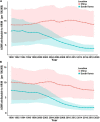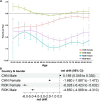Stroke mortality attributable to high red meat intake in China and South Korea: An age-period-cohort and joinpoint analysis
- PMID: 36313118
- PMCID: PMC9614311
- DOI: 10.3389/fnut.2022.921592
Stroke mortality attributable to high red meat intake in China and South Korea: An age-period-cohort and joinpoint analysis
Abstract
The high intake of red meat is well recognized as a major health concern worldwide. It has been recognized as a risk factor for several non-communicable chronic diseases, including stroke. However, previously published studies have not performed a comprehensive analysis of the long-time trend of stroke mortality attributable to high red meat intake in China and South Korea, two countries with similar dietary patterns and changing trends. Therefore, this study aimed to reveal the influence of age, time period, and birth cohort on long-term trends of stroke mortality attributable to high red meat intake and relative gender differences in China and South Korea. Data were obtained from the Global Burden of Disease 2019 database. The age-period-cohort model was used to estimate the effect of age, time period, and birth cohort. The average and annual percent changes were estimated using the joinpoint regression analysis. Results indicated that the overall attributable age-standardized mortality rates of stroke in China decreased by 1.0% (P < 0.05) for female and 0.1% (P > 0.05) for male individuals, compared with a decrease of 4.9% for female and 3.7% for male individuals in South Korea (both P < 0.05). Age-period-cohort analysis revealed that the attributable stroke mortality decreased along with the time period, and increased along with age. Significant gender differences were observed, male individuals in both countries were at higher risk than their female counterparts, especially in China. Joinpoint analysis suggested that the attributable stroke mortality for both genders in South Korea and female individuals in China showed a decreasing trend, while it is stable for male individuals in China. Although prominent reductions were observed during the past decades, the attributable stroke mortality risk in China and South Korea is still high. Our findings indicate that controlling the intake of red meat may be a cost-effective strategy to reduce stroke mortality risk and the corresponding disease burden, especially for Chinese male individuals.
Keywords: China; South Korea; age-period-cohort analysis; high red meat intake; joinpoint analysis; stroke mortality.
Copyright © 2022 Chen, Hu, Chen, Si, Zhang and Ma.
Conflict of interest statement
The authors declare that the research was conducted in the absence of any commercial or financial relationships that could be construed as a potential conflict of interest.
Figures




Similar articles
-
Burden of ischemic stroke attributable to a high red meat diet in China, 1990-2019: analysis based on the 2019 Global Burden of Disease Study.Front Nutr. 2024 Jun 6;11:1384023. doi: 10.3389/fnut.2024.1384023. eCollection 2024. Front Nutr. 2024. PMID: 38912303 Free PMC article.
-
Stroke Mortality Attributable to Low Fruit Intake in China: A Joinpoint and Age-Period-Cohort Analysis.Front Neurosci. 2020 Dec 1;14:552113. doi: 10.3389/fnins.2020.552113. eCollection 2020. Front Neurosci. 2020. PMID: 33335466 Free PMC article.
-
[Disease burden of colorectal cancer attributable to dietary risk factors from 1990 to 2019 in China].Zhonghua Liu Xing Bing Xue Za Zhi. 2024 Feb 10;45(2):200-206. doi: 10.3760/cma.j.cn112338-20230919-00168. Zhonghua Liu Xing Bing Xue Za Zhi. 2024. PMID: 38413057 Chinese.
-
Long-Time Trend of Colorectal Cancer Mortality Attributable to High Processed Meat Intake in China and a Bayesian Projection from 2020 to 2030: A Model-Based Study.Int J Environ Res Public Health. 2022 Aug 25;19(17):10603. doi: 10.3390/ijerph191710603. Int J Environ Res Public Health. 2022. PMID: 36078321 Free PMC article.
-
Temporal trends of ischemic stroke attributable to diet high in sodium in China from the global burden of disease study 2021.Front Nutr. 2025 Mar 13;12:1513981. doi: 10.3389/fnut.2025.1513981. eCollection 2025. Front Nutr. 2025. PMID: 40181950 Free PMC article.
Cited by
-
The Role of Methionine-Rich Diet in Unhealthy Cerebrovascular and Brain Aging: Mechanisms and Implications for Cognitive Impairment.Nutrients. 2023 Nov 3;15(21):4662. doi: 10.3390/nu15214662. Nutrients. 2023. PMID: 37960316 Free PMC article. Review.
-
Plant-based diets-impacts of consumption of little or no animal-source foods on human health.Front Nutr. 2024 Sep 18;11:1423925. doi: 10.3389/fnut.2024.1423925. eCollection 2024. Front Nutr. 2024. PMID: 39360272 Free PMC article.
-
Temporal trends of the burden of ischemic stroke attributable to high low-density lipoprotein cholesterol in China from 1999 to 2019.BMC Public Health. 2024 Oct 30;24(1):3003. doi: 10.1186/s12889-024-20461-5. BMC Public Health. 2024. PMID: 39478553 Free PMC article.
-
Analysis and projections of disease burden for different risk factors and sexes of ischemic stroke in young adults in China.Sci Rep. 2024 Jun 10;14(1):13339. doi: 10.1038/s41598-024-63920-0. Sci Rep. 2024. PMID: 38858463 Free PMC article.
References
-
- Walker ME, O’Donnell AA, Himali JJ, Rajendran I, Melo Van Lent D, Ataklte F, et al. Associations of the mediterranean-dietary approaches to stop hypertension intervention for neurodegenerative delay diet with cardiac remodelling in the community: the framingham heart study. Br J Nutr. (2021) 126:1888–96. 10.1017/S0007114521000660 - DOI - PMC - PubMed
LinkOut - more resources
Full Text Sources
Miscellaneous

